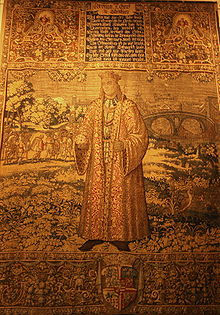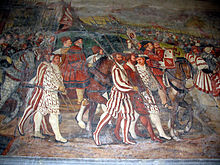Christian I of Denmark
| Christian I | |
|---|---|
King of Sweden | |
| Reign | 23 June 1457 – 23 June 1464 |
| Coronation | 29 June 1457, Uppsala |
| Predecessor | Charles VIII |
| Successor | Charles VIII |
| Count of Oldenburg | |
| Reign | 1440-1448 |
| Predecessor | Dietrich I |
| Successor | Gerhard VI |
| Born | February 1426 Oldenburg, Holy Roman Empire |
| Died | 21 May 1481 (aged 55) Copenhagen Castle |
| Burial | |
| Spouse | |
| Issue among others... |
|
| House | Oldenburg |
| Father | Dietrich, Count of Oldenburg |
| Mother | Helvig of Schauenburg |
Christian I (February 1426 – 21 May 1481) was a
In the
In 1460, following the death of his uncle,
Biography
Early years
Christian I was born in February 1426 in
Through his father, he belonged to the
At the death of their father in 1440, Christian and his brothers jointly succeeded Dietrich as Count of Oldenburg and Delmenhorst. Christian was raised by his uncle, Duke Adolphus of Schleswig, Count of Holstein (1401–1459) as the childless duke wished for his young nephew to become his heir, and also succeeded in having Christian elected as his successor in the Duchy of Schleswig.[3]
King of Denmark



In January 1448, King
King of Sweden and Norway

Meanwhile, Sweden had on 20 June 1448 elected
However, the Swedish nobility now took steps to avoid war with Denmark. In June 1450, the Swedish Council of the Realm forced Charles to renounce his claim on Norway to King Christian. In the summer of 1450, Christian sailed to Norway with a large fleet, and on 2 August he was crowned king of Norway in
Charles Knutsson became increasingly unpopular as king of Sweden, and was driven into exile in 1457. Christian achieved his aim of being elected as king of Sweden, thus re-establishing the Kalmar Union. He received the power from temporary Swedish regents Archbishop
Duke and Count
In 1460 King Christian also became Duke of
Later reign


Christian's personal territory was at its largest in 1460–1464, before the loss of Sweden. However, many parts of his realm wanted to govern themselves locally, and there were constant struggles. Denmark was his most important center of power.[citation needed]
In 1474 Christian travelled two times: in April he went to

Acting on a permission from Pope Sixtus IV in 1475 to establish a university in Denmark, the University of Copenhagen was inaugurated by Christian on 1 June 1479.[citation needed]
Death and burial

King Christian died at
Legacy
The dynasty he founded, the House of Oldenburg, remains on the throne of Denmark. It was on the throne of Norway until 1818, returning there again from 1905, and also on the throne of Sweden during Christian's reign there and those of his son and grandson, but also 1751–1818.[9]
Arms
-
Coat of arms as Count of Oldenburg.
-
Coat of arms as King of Denmark, the Goths and the Wends.
-
Coat of arms as King of Denmark, Sweden, Norway and the Wends.
-
Coat of arms as King of Denmark, Sweden, Norway and the Wends and Duke of Schleswig-Holstein.
-
Coat of arms on fresco in Roskilde Cathedral, alongside Queen Dorothea's coat of arms (right)
Ancestry
| Ancestors of Christian I of Denmark | |||||||||||||||||||||||||||||||||||||||||||||||||||||||||||||||||||||||||||||||||||||||||||||||||||||||||||||||||||||||||||||||||||||||||||||||||||||||||||||||||||||||||||||||||||||||||||||||||||||
|---|---|---|---|---|---|---|---|---|---|---|---|---|---|---|---|---|---|---|---|---|---|---|---|---|---|---|---|---|---|---|---|---|---|---|---|---|---|---|---|---|---|---|---|---|---|---|---|---|---|---|---|---|---|---|---|---|---|---|---|---|---|---|---|---|---|---|---|---|---|---|---|---|---|---|---|---|---|---|---|---|---|---|---|---|---|---|---|---|---|---|---|---|---|---|---|---|---|---|---|---|---|---|---|---|---|---|---|---|---|---|---|---|---|---|---|---|---|---|---|---|---|---|---|---|---|---|---|---|---|---|---|---|---|---|---|---|---|---|---|---|---|---|---|---|---|---|---|---|---|---|---|---|---|---|---|---|---|---|---|---|---|---|---|---|---|---|---|---|---|---|---|---|---|---|---|---|---|---|---|---|---|---|---|---|---|---|---|---|---|---|---|---|---|---|---|---|---|
| |||||||||||||||||||||||||||||||||||||||||||||||||||||||||||||||||||||||||||||||||||||||||||||||||||||||||||||||||||||||||||||||||||||||||||||||||||||||||||||||||||||||||||||||||||||||||||||||||||||
Danish royal descent
Issue
| Name | Birth | Death | Notes |
|---|---|---|---|
| Olaf | 1450 | 1451 | |
| Canute | 1451 | 1455 | |
| John | 2 February 1455 | 20 February 1513 | King of Denmark, Norway and Sweden. Had issue. |
| Margaret | 23 June 1456 | 14 July 1486 | Married King James III of Scotland in 1469. Had issue. |
| Frederick I | 7 October 1471 | 10 April 1533 | King of Denmark and Norway. Had issue. |
See also
- List of Danish monarchs
- Danish monarch's family tree
References
- ISBN 0 85011 023 8p. 68
- ^ "Battle of Brunkeberg 1471". tripod.com. Retrieved 1 June 2018.
- ^ "Adolf VIII". Allgemeine Deutsche Biographie. Retrieved 1 June 2018.
- ^ "Dorothea, 1430-95, Dronning". Dansk biografisk Lexikon. Retrieved 1 June 2018.
- ^ "Erik Axelsson Tott". Biografiskt lexikon för Finland 1. Svenska tiden. Retrieved 1 June 2018.
- ^ Christer Engstrand. "Kettil Vasa (Karlsson)". historiska-personer.nu. Archived from the original on 9 September 2016. Retrieved 1 June 2018.
- ^ "Jöns Bengtsson (Oxenstierna)". Svenskt biografiskt lexikon. Retrieved 1 June 2018.
- ^ Örjan Martinsson. "Sten Sture den äldre". Tacitus.nu. Archived from the original on 22 April 2022. Retrieved 1 June 2018.
- ISBN 0-85011-023-8p 60
Bibliography
- Arup, Erik (1902–1904). "Den finansielle side af erhvervelsen af hertugdømmerne 1460–1487" [The financial side of the acquisition of the duchies 1460–1487]. Historisk Tidsskrift (in Danish). 4 (7). Copenhagen: Den danske historiske Forening: 317–388, 399–489.
- Carstens, W. (1931). "Die Wahl König Christian I. von Dänemark zum Herzog von Schleswig und Graf von Holstein im Jahre 1460" [The election of King Christian I of Denmark as Duke of Schleswig and Count of Holstein in 1460]. Zeitschrift der Gesellschaft für Schleswig-Holsteinische Geschichte (in German). 60. Kiel: Gesellschaft für Schleswig-Holsteinische Geschichte.
- Dahlerup, Troels (1989). De fire stænder. 1400–1500 [The four estates. 1400–1500.]. ISBN 87-89068-08-4.
- Hermansen, Victor (1950). Christiern den Førstes højde [The height of Christiern the First] (in Danish). Nationalmuseet.
- Hille, Georg (1876), "Christian I.", Allgemeine Deutsche Biographie (in German), vol. 4, Leipzig: Duncker & Humblot, pp. 180–184
- Jahnke, Carsten (2014). "Two Journeys and One University: King Christian I and Queen Dorothea's Journeys to Rome and the Foundation of the University of Copenhagen". Denmark and Europe in the Middle Ages, c. 1000–1525: Essays in Honour of Professor Michael H. Gelting. pp. 139–153.
- Mollerup, William (1889). "Christian I". Dansk biografisk Lexikon. Vol. 3 (1st ed.) – via Project Runeberg.
- Odd Johnsen, Arne (1947–1949). "Kong Christian I.s forbundspakt med Karl den Dristige av Burgund og hans allierte (1467)" [King Christian I's Covenant Pact with Charles the Bold of Burgundy and his Allies (1467)]. Historisk Tidsskrift (in Norwegian). 11 (2). Copenhagen: Den danske historiske Forening: 111–131.
- Poulsen, Bjørn (1988). Land – by – marked: to økonomiske landskaber i 1400-tallets Slesvig (PDF) (in Danish). ISBN 87-89178-00-9.)
{{cite book}}: CS1 maint: location missing publisher (link - Platte, Hartmut (2006). Das Haus Oldenburg (in German). ISBN 3-9810315-4-7.
- Scocozza, Benito (1997). "Christian 1.". Politikens bog om danske monarker [Politiken's book about Danish monarchs] (in Danish). ISBN 87-567-5772-7.
- Suhr, Wilhelm (1957), "Christian I.", Neue Deutsche Biographie (in German), vol. 3, Berlin: Duncker & Humblot, pp. 232–233; (full text online)
- Tjällén, Biörn (2020). "King Bottomless Empty Purse': Taxes, Avarice and Pastoral Care in the Swedish Reign of Christian I (1457–64)". .
External links
- The Royal Lineage Archived 14 March 2015 at the Danish Monarchy






